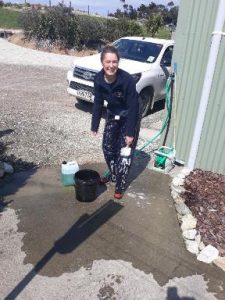Overcoming Salmonella

In August Northland vet Rory Dean was called out to a farm and diagnosed salmonella.

He details his and the farmer’s response to the extremely contagious disease that was carefully treated and managed for a positive outcome.
During an unusual dry spell in August, farmer Joel Courtman, who milks 470 cows, decided to start grazing 30 hectares of new grass, first time with the milkers.
Hay was already being added to the feed in the mixer wagon and he decided to feed more out on the paddocks.
After five or so days three cows were noticed being off their milk and were passing loose bubbly dung.
‘The initial concern was acidosis, but after evaluating the diet, the herd dung consistency and taking some temperatures, I was quickly suspicious of salmonella.’
Management policy is to draft anything that doesn’t look right. The cows were drafted and treated for acidosis and put in the hospital paddock. Two days later three more cows presented with the same symptoms and the other three cows weren’t getting better. The next morning two more cows were found passing blood.
“The vet was called and Rory came that day. He was very certain it was salmonella. Rory couldn’t stress enough on how contagious it was,” Joel says.
“The cowshed was hosed and disinfected. The herd homes were disinfected by a motorbike boom sprayer every three days and after every new case was isolated. The animals stayed separate by themselves in the same paddock.”
No animals from the original hospital paddock entered the main herd until four weeks after the full vaccination course. The infected cows were milked last every three days.
“The team treated 16 cases, one of which died. Eight would have come back into milk but after a farm meeting it was decided all would be dried off and taken to the beef side of the farm. Hats off to my staff for going the extra mile,” Joel says.
Vet Rory Dean says Joel and his team managed this outbreak excellently and the case represents how biosecurity can truly make all the difference with a salmonella outbreak.
“The initial concern was acidosis, but after evaluating the diet, the herd dung consistency and taking some temperatures, I was quickly suspicious of salmonella.
“After further investigation, it was clear that through no fault of their own, the team had also encountered a number of risk factors for salmonella. The addition of fresh lush feed, the presence of wild birds in and around the feed bunker, areas of standing water and cows under physiological stress (calving time) unfortunately made a ‘perfect storm’ for a salmonella outbreak.

“On my initial visit, we treated cows initially with a long-acting anti-inflammatory injection, 40 litres of fluids containing electrolytes, an oxytetracycline antibiotic. These cows were immediately isolated. I set out a clear treatment/isolation protocol which was strictly adhered to by staff, which led to the relatively low number of infected cows and deaths,” Rory says.
Laboratory samples quickly returned as salmonella, and provided information on which antibiotics to use – in this case the antibiotic used, oxytetracycline, was effective.
“After this laboratory confirmation, we decided to vaccinate the herd. Vaccination is useful in herds affected by salmonella, as it helps slow transmission and prevent new cases. It has to be carefully considered, as the vaccine can cause the cows to spike a slight temperature in the following 24-48 hours.
“Encouragingly, a week later, the number of cases in the milking herd were slowing, and all but one of the animals had responded to treatment.”
Unfortunately, nearly a fortnight after the initial visit, Joel called asking to discuss some sick calves. Many of the calves had a high temperature and seemed depressed. Some appeared weak. Affected calves were treated and isolated quickly. Samples sent off to the lab indicated there was a mixed infection of rotavirus and salmonella. These responded well to treatment and no deaths were recorded.
“The textbook management of this case by Joel and his team is a main factor behind the low mortality in this case,” Rory says.
“Salmonella outbreaks can be devastating; often involving lots of dead animals, sick staff, lots of milk discarded, and high treatment costs. These were avoided in this case by good cleansing and disinfection, which interrupted the cycle of infection, and the early instigation of an aggressive treatment/isolation regimen.”
The bug
Salmonella are bacteria that cause a variety of disease in many animals. In humans, salmonella can cause enteritis – diarrhoea, abdominal cramps, and high fever. It is most commonly associated with poor food hygiene, and improper cooking in the developed world.
It is a major source of disease in developing nations, due to poor water sanitation. Most healthy adults will overcome the disease within a few days, but those with underlying health conditions, the elderly, children and pregnant women can be more severely affected and may require hospitalisation.
Most domestic animals can be affected by salmonella, Rory says. This is due to many of the salmonella bacteria being non-host-specific – they can successfully infect several species of animals. The bacteria can infect multiple species with serovar, or bacterial subtype. Unfortunately, one of the major subtypes infecting farmed cattle in New Zealand, Salmonella typhimurium, is very well adapted to cause disease in several species, including humans.
The disease in adult dairy cattle typically follows a ‘classic’ progression:
- Massive milk drop, depression, reduced feed intake, gaunt appearance, high fever (40-41C)
- Diarrhoea, containing blood, gut lining (RFM afterbirth), dehydration, severely affected animals become recumbent and may die, despite aggressive treatment.
Other syndromes of the disease occur in cattle, including abortion outbreaks and meningitis, but diarrhoea is the most common sign. Severity of disease is highly dependent on dose and virulence of the salmonella species involved, as well as many cow factors, he says.
Farmers who have battled salmonella and learned from this progression are often the best at managing it; if the disease is treated early, good outcomes may be achieved.
In calves under six months old, salmonella can cause a multitude of clinical signs, which may be confusing at first. Although diarrhoea is still the main clinical sign, calves may also suffer a fatal meningitis, joint infections and septicaemia. Buying in animals is a real risk factor for salmonella in young stock.
Diagnosis
It is imperative to involve your vet early if you are concerned about salmonella, Rory says. By simply phoning the vet and explaining the signs, your vet can help put in place measures to slow the progression and spread of the disease.
Attempting treatment without considering biosecurity, isolation, proper laboratory diagnosis, vaccination and targeted therapy will simply delay the resolution of the outbreak, if salmonella is the cause. Early diagnosis and management is essential to minimise losses and prevent staff from becoming sick.
Your vet may opt to take samples of dung and or blood which will be sent off to the laboratory for evaluation.
Treatment
Identifying sick animals early and isolating them from the rest of the herd is the mainstay behind management of salmonella. The best tool is good, old fashioned stock sense, and a thermometer, Rory says. Your vet will create a plan for identifying, isolating, and treating affected animals which may consist of:
- Anti-inflammatory – An anti-inflammatory injection is really valuable in countering the fever in affected animals as well as improving demeanour, appetite and the effects of toxaemia.
- Fluids – Cows can quickly become dehydrated, and Agger’s pumps make giving a sick cow 40 litres of electrolytes quick and easy. An appropriate electrolyte sachet will be prescribed/used by your vet. Remember, if a cow’s eyes are sunken, she may be up to 10% dehydrated, meaning she needs 40-50 litres for rehydration.
- Isolation – Cows should be isolated in to a ‘Salmonella Mob’ which is milked last. After milking these animals, thorough cleaning and disinfection of the milking shed is essential to minimise spread to the rest of the herd.
- Nursing care – Remember to carefully lift down animals, and affected animals should have ready access to fresh water, and good food. Consider euthanising animals that have been down for more than 48 hours and are still depressed/dehydrated despite aggressive treatment.
- Antibiotics – Your vet will tell you whether antibiotic treatment is indicated, and which drug to use based on the clinical picture, experience, and lab results.




